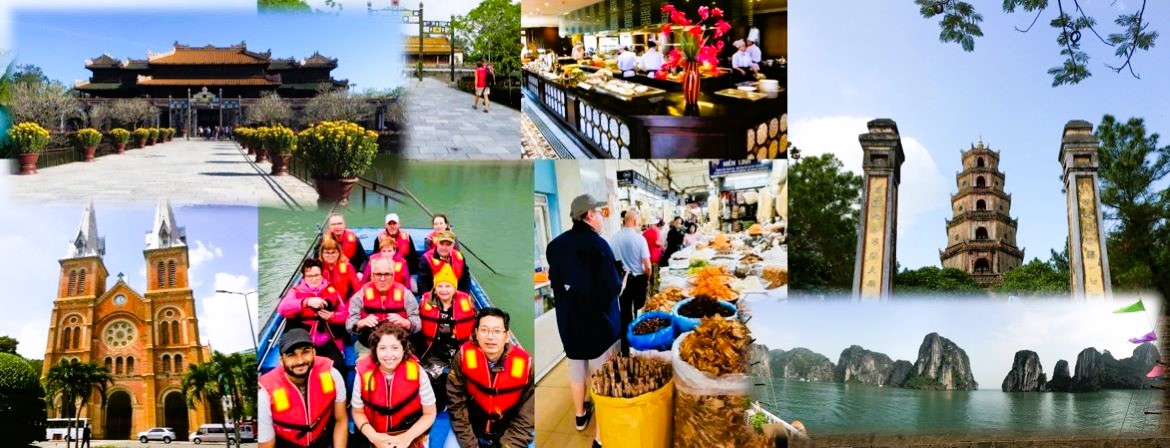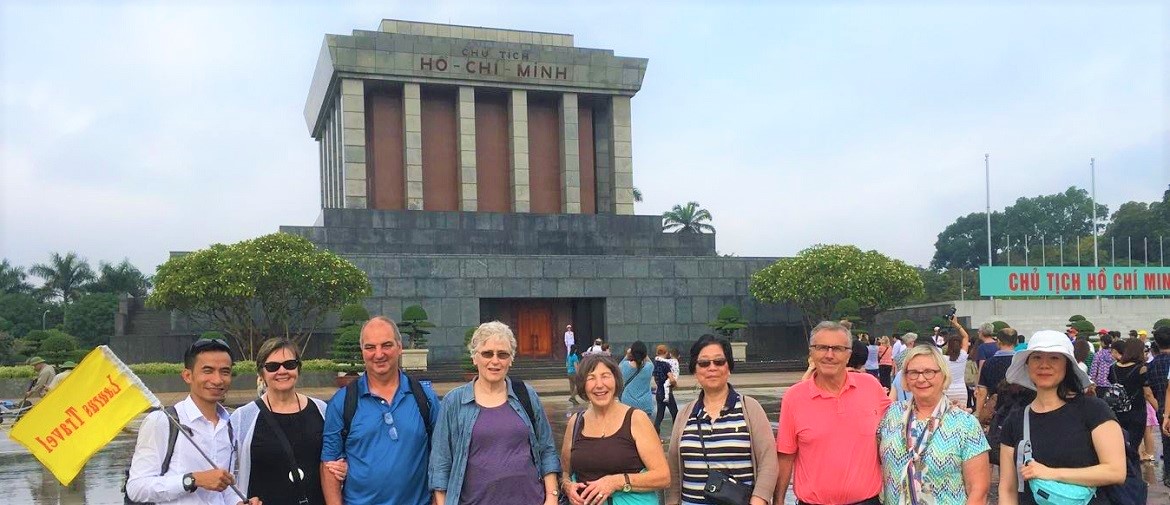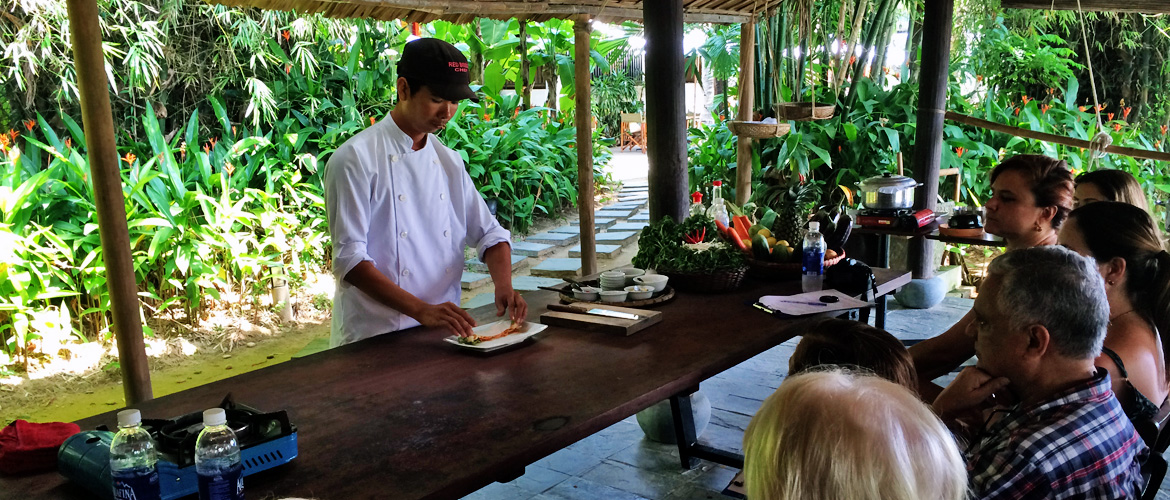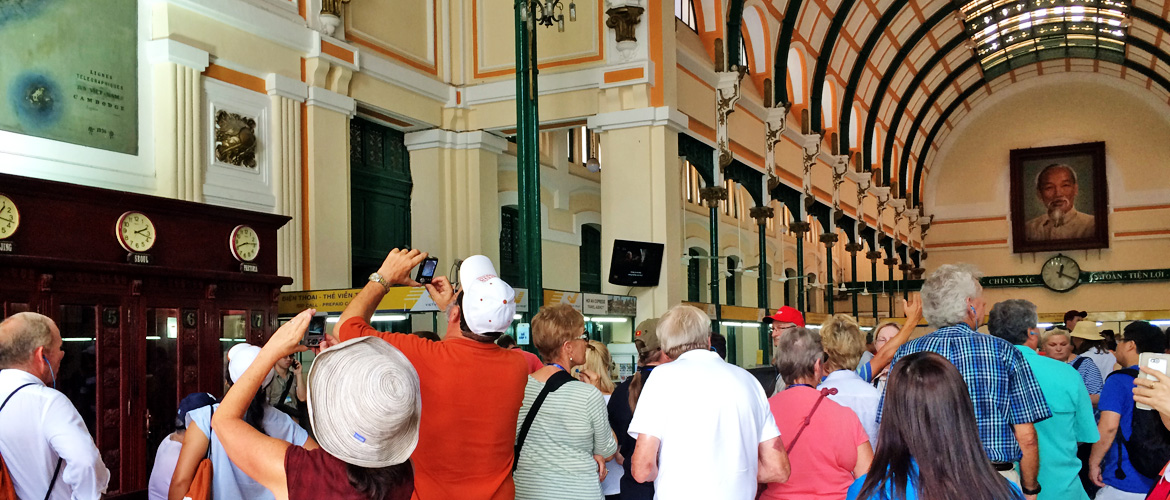Hanoi – Ha Long Bay – Hue – Da Nang – Hoi An – Ho Chi Minh City

Nestled in the heart of Southeast Asia, Vietnam beckons with a tapestry of experiences that seamlessly blend the ancient and the modern. From the fascinating chaos of bustling markets to the serene beauty of UNESCO-listed landscapes, Vietnam is a destination that captivates the soul.
Join us on this extraordinary Best of Vietnam tour and unlock a world of wonders. Let the vibrant culture, stunning landscapes, and warm hospitality create memories that will last a lifetime.
Important Features
- Small group size – average 15, maximum 20.
- Experienced tour leader & local guides.
- Overnight cruise on Ha Long Bay aboard a luxury ship.
- No forced shopping stops.
- High-quality local and Western meals.
- Unlimited supply of bottled water.
- Free Wi-Fi in every hotel.
- Water puppet show in Hanoi.
- Cooking class in Hoi An.
Meal Code: B = breakfast / L = lunch / D = dinner

Day 1/Thu: Departing Home City
The journey begins with your transpacific flight departing from a city of your choice. You’ll lose a day upon crossing the International Date Line.
Day 2/Fri: Arrival in Hanoi
Welcome to Hanoi! Meet your guide on arrival and transfer to the hotel. The remainder of the day is at leisure. Airport transfer for guests arriving ahead of tour schedule is not included and taxi fare is about $15 US.
Day 3/Sat: Hanoi (B/L/D)
Hanoi is the capital and the second largest city of Vietnam with a population currently estimated at 2.2 million excluding residents in the suburban areas. The ancient city has had many names throughout history, all of them of Sino-Vietnamese origin. Hanoi received its current name from Emperor Minh Mang in 1831. Ha and Noi mean “river” and “in between” respectively, to reflect the fact that the city sits between Red River and To Lich River. Hanoi was the most important political centre of Vietnam between 1010 and 1802. It was eclipsed by Hue during the Nguyen Dynasty (1802–1945). The city served as capital of French Indochina from 1902 to 1954. After the French were driven out in 1954, Hanoi became the capital of North Vietnam and subsequently capital of the unified Socialist Republic of Vietnam since 1975.
Our city tour following orientation in the hotel takes in the Presidential Palace, Ho Chi Minh Mausoleum, Vietnam National Museum of History, the Old Quarter and a traditional water puppet show.
The Presidential Palace was built between 1900 and 1906 to house the French Governor-General of Indochina. When Vietnam achieved independence in 1954, Ho Chi Minh (1890-1969) declined to live in the grand structure for symbolic reasons. Instead, a traditional Vietnamese stilt house was built for him in the same complex and he lived in it until he passed away. The palace is used for government functions and beyond access of the public. The Ho Chi Minh Mausoleum is located nearby the palace.
The National Museum of History is housed in the former home of the French School of the Far East (École française d’Extrême-Orient, EFEO for short). EFEO, founded in Hanoi in 1900 and now based in Paris, is a leading institution focused on the study of archaeology, philology, and modern society of East Asia. In 2011, the National Museum merged with the Vietnam Museum of Revolution across the street. This merger expanded the exhibition area to 4,000 square metres and the objects on regular display to over 10,000 with a timeline from prehistory to the establishment of the Socialist Republic of Vietnam in 1945.
The Old Quarter near Hoan Kiem Lake has the original street layout and architecture of old Hanoi. At the beginning of the 20th century the city consisted of only about 36 streets, most of which are now part of the old quarter. A night market (near Dong Xuan Market) in the heart of the district opens for business on weekends offering a variety of clothing, souvenirs and food.
We attend a traditional water puppet show later in the day. The show is performed in a waist-deep pool with the surface of water as stage. The puppets are made out of wood and then lacquered. The puppeteers standing behind a split-bamboo screen control the puppets using long bamboo rods and a string mechanism hidden beneath the water surface. The themes are rural, with strong reference to Vietnamese folklore. Stories of harvesting, fishing and festivals are highlighted, often with a humorous twist. Legends and national history are also told through short skits.
We wrap up the day with a delicious welcome dinner.
Day 4/Sun: Hanoi – Ha Long Bay (B/L/D)
Our morning drive to Ha Long Bay takes about two and half hours. Board the luxurious junk on arrival. Our overnight cruise on Ha Long Bay includes visits to a sandy beach and a limestone cave full of stalactites and stalagmites.
Inscribed in 1994 by UNESCO as a World Heritage Site, Ha Long Bay, located in the Gulf of Tonkin and 165 kilometres from Hanoi, covers an area of 43,400 hectares and includes over 1,600 islands and islets. The exceptional scenic beauty of the limestone pillars complemented by biological interest is an ideal model of a mature karst landscape developed during a warm and wet tropical climate. The outstanding value of Ha Long Bay is centered around the drowned limestone karst landforms, displaying spectacular pillars with a variety of coastal erosional features such as arches and caves which form a majestic natural scenery.
Day 5/Mon: Ha Long Bay – Hanoi – Hue (B/L/D)
After a leisurely breakfast, we disembark the boat and drive back to Hanoi. We tour the Temple of Literature after lunch. The temple is dedicated to the Chinese sage Confucius and traces its history all the way back to the year of 1070.
The later afternoon or early evening flight to Hue takes just over one hour. Please note that, if the flight schedule makes it impossible for the planned dinner to be served, it will be moved over to the next day.
Day 6/Tue: Hue (B/L)
Hue was Vietnam’s national capital until 1945, when Emperor Bao Dai abdicated and a communist government was established in Hanoi in the north. During the Vietnam War, Hue’s central location very near the border between the North and South put it in a vulnerable position. In the Tet Offensive of 1968, during the Battle of Hue, the city suffered considerable damage due to a combination of the American military bombing of historic buildings held by the North Vietnamese and the massacre committed by the communist forces.
Our sightseeing in Hue today takes in the massive citadel encompassing the Imperial City, Emperor Tu Duc’s Tomb, and Thien Mu Pagoda. We end the day with an hour-long boat cruise on Perfume River.
Day 7/Wed: Hue – Da Nang – Hoi An (B/D)
Have some free time after breakfast. The late morning drive to Da Nang (92 km) on the winding highway by the South China Sea is simply spectacular. We will make a couple of photo stops before visiting the Museum of Cham Sculpture, a highlight in Da Nang.
Da Nang is a major port city in central Vietnam known for its sandy beaches and French colonial history. During the Vietnam War, what is now the Da Nang International Airport was a major air base used by the South Vietnamese and United States Air Forces.
We continue our overland journey after the museum visit. The drive from Da Nang to Hoi An takes less than half an hour (30 km).
Day 8/Thu: Hoi An (B/L)
The early history of Hoi An is that of the Cham people, who created the Champa Empire which occupied much of what is now central and lower Vietnam, from Hue to beyond Nha Trang. Europeans first reached Hoi An in the early 16th century when it was still known as Hai Fo. In the 18th century, Hoi An was considered by Chinese and Japanese merchants to be among the best destinations for trading in all of Southeast Asia. But its importance waned sharply at the end of the 18th century as a result of domestic turmoil and the rise of Da Nang after the Vietnamese imperial court granted the French exclusive trade rights to Da Nang.
Our morning tour of the food market in the town centre is followed by a cooking class. We then spend the rest of the day exploring the ancient town of Hoi An, a UNESCO-inscribed World Heritage Site. Our walking tour takes in the 400-year-old Japanese Covered Bridge, Sa Huynh Museum, Tran Family Chapel, Phuoc Kien Assembly Hall, and a lantern making workshop.
Day 9/Fri: Hoi An – Ho Chi Minh City (B/L/D)
After breakfast we drive back to Da Nang (30 km) to fly to Ho Chi Minh City (1 ½ hours).
Ho Chi Minh City, HCMS for short, is the largest city in Vietnam, with a population of over 9 million. Formerly named Saigon, it lies 1,160 km (720 miles) south of Hanoi and 605 km (375 miles) southwest of Da Nang.
Ho Chi Minh City began as a small fishing village called Prey Nokor inhabited by Khmer people, who lived here for centuries before the arrival of the Vietnamese. Beginning in the early 17th century, colonization of the area by Vietnamese settlers gradually isolated the Khmers of the Mekong Delta from their brethren in Cambodia proper and resulted in their becoming a minority in the delta. Increasing waves of Vietnamese settlers, which the Cambodian kingdom could not impede because it was weakened by war with Thailand, slowly Vietnamized the area. In time, Prey Nokor became known as Saigon. Prey Nokor was the most important commercial seaport to the Khmers and the loss of the city and the rest of the Mekong Delta cut off Cambodia’s access to the East Sea. Subsequently, the only remaining sea access for the Khmers was southwesterly at the Gulf of Thailand.
Under the name Saigon, the city served as capital of the French colony of Cochinchina from 1862 to 1954 and later of the independent republic of South Vietnam from 1955 to 1975. Saigon was officially renamed Ho Chi Minh City on July 2, 1976.
Our sightseeing this afternoon begins with a stroll along Dong Khoi Street, formerly known as Catinat Street, the main shopping district and heart of the old colonial Saigon. Highlights include such classic European-style landmarks as Hotel De Ville, the old Opera House, Notre Dame Cathedral and the Central Post Office.
Day 10/Sat: Ho Chi Minh City (B/L)
After breakfast we embark on an excursion to Cu Chi Tunnels. Stretching over 200 km, this incredible underground network was an important Viet Cong base during the Vietnam War. The tunnels were used by Viet Cong soldiers as hiding spots during combat as well as communication and supply routes, hospitals, food and weapon caches and living quarters. The tunnels were also the Viet Cong’s base of operations for the Tet Offensive in 1968.
We return to the city following lunch and spend the rest of the day exploring the War Remnants Museum and the Reunification Palace. Formerly the presidential palace of the South Vietnamese government, the Reunification Palace was stormed by Viet Cong troops on April 30, 1975, signifying the fall of the Republic of Vietnam commonly known as South Vietnam.
Day 11/Sun: Ho Chi Minh City (B)
Free day to explore on your own.
Day 12/Mon: Ho Chi Minh – Home City (B)
Your Vietnam tour ends today. Transfer to the airport anytime for return flight. Your airport transfer is included unless you choose to extend your stay. Arrive home the same day after re-crossing the International Date Line.

Dates & Prices
| Depart (Thu) | Return (Mon) | Land Only CA$/US$ |
Single Supplement CA$/US$ |
| 2025 |
|||
| 30-Oct | 10-Nov | $3990/$2850 | $1390/$995 |
| 06-Nov | 17-Nov | $3990/$2850 | $1390/$995 |
| 13-Nov | 24-Nov | $3990/$2850 | $1390/$995 |
| 20-Nov | 01-Dec | $3990/$2850 | $1390/$995 |
| 27-Nov | 08-Dec | $3990/$2850 | $1390/$995 |
| 2026 | |||
| 08-Jan | 19-Jan | $4195/$2995 | $1390/$995 |
| 15-Jan | 26-Jan | $4195/$2995 | $1390/$995 |
| 22-Jan | 02-Feb | $4195/$2995 | $1390/$995 |
| 29-Jan | 09-Feb | $4195/$2995 | $1390/$995 |
| 05-Feb | 16-Feb | $4195/$2995 | $1390/$995 |
| 26-Feb | 09-Mar | $4195/$2995 | $1390/$995 |
| 05-Mar | 16-Mar | $4195/$2995 | $1390/$995 |
| 12-Mar | 23-Mar | $4195/$2995 | $1390/$995 |
| 19-Mar | 30-Mar | $4195/$2995 | $1390/$995 |
| 26-Mar | 06-Apr | $4195/$2995 | $1390/$995 |
|
What the tour price includes:
|
What the tour price excludes:
See Terms & Conditions for more information. |

Passport
A passport with at least one blank visa page and six (6) months validity at the end of the tour is required.
Visa
Vietnamese e-visa can be easily obtained online and we advise you to apply within 30 days of travel. We are ready to assist you with your application. If you do it yourself, deal with the appropriate authorities directly and avoid any middleman – some of them use domain names ending with .govt.vn or .org to fool the public.
Vietnam Tourist e-Visa – US$25
https://evisa.xuatnhapcanh.gov.vn/
https://www.xuatnhapcanh.gov.vn
Immunization
Visitors may be asked to show proof of vaccinations against COVID-19 prior to or on arrival. COVID testing prior to arrival is no longer required.
We are not aware of any other inoculation requirements and we suggest you visit the websites of your national government’s disease control centre and pertinent embassies in your country for the latest. We recommend all of our guests to be vaccinated against hepatitis A.
Tips on Staying Healthy
Do not drink from the tap when you travel. Ask for bottled or boiled water when eating in restaurants. When buying bottled water from street vendors, especially at tourist sites, make sure the cap is properly sealed because some vendors may be selling tap water in recycled bottles.
Try to avoid uncooked food. Raw food, even clean, may still cause stomach upset or diarrhoea.
Always carry a roll of toilet paper and a bottle of hand sanitizer containing more than 60% of alcohol, no matter where you go.
Always have an N95 type of facemask ready. Passengers sitting next to you may be sick and cough loudly but wear nothing to cover their mouth. This was a big problem before the pandemic that may return soon.
Banknotes in general are filthy and carry all kinds of germs. Minimize your contact with local banknotes and coins by keeping them in a plastic bag and sanitize your hands every time you touch them. Use plastic for payment as much as possible.
Currency & Credit Card
Vietnam currency: Dông (VND)
Cambodia currency: Riel (KHR)
Thai currency: Baht (THB)
Please keep your inventory of local currencies to the minimum. Your tour fare covers all the expensive items already. You only need some local cash, which can be easily obtained as you go, for souvenirs and meals not included in the tour price.
Consider using a credit card for transactions over $20. Major credit cards such as Visa and MasterCard are widely accepted throughout Southeast Asia. Street vendors in Vietnam and Cambodia prefer U.S. dollars to their own currency but you should exercise caution if you want to play along. Merchants in more prosperous Thailand only accept their own currency if you pay by cash.
Travel Insurance – When to Buy
We will save your deposit as credit if you cancel at any time and for any reason. The transferrable credit has no expiration date. Therefore, it may be unnecessary to pay $30 to $50 on cancellation insurance for your deposit.
However, you should definitely consider purchasing trip cancellation & emergency medical insurance when your balance is due. If you don’t have proper coverage, the loss can be devastating if you were forced to cancel close to departure date or ran into a serious medical emergency during the trip. Please ask us for insurance quotes when your balance is due.

